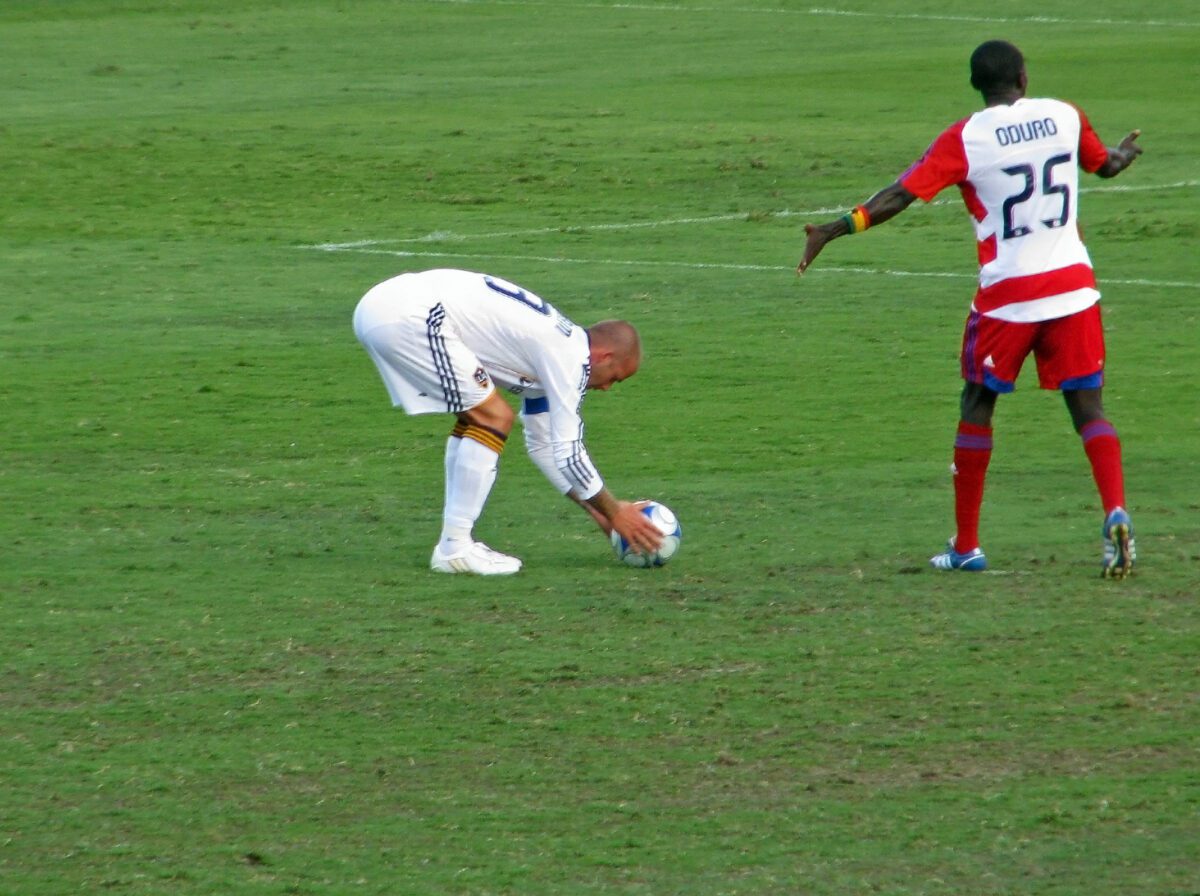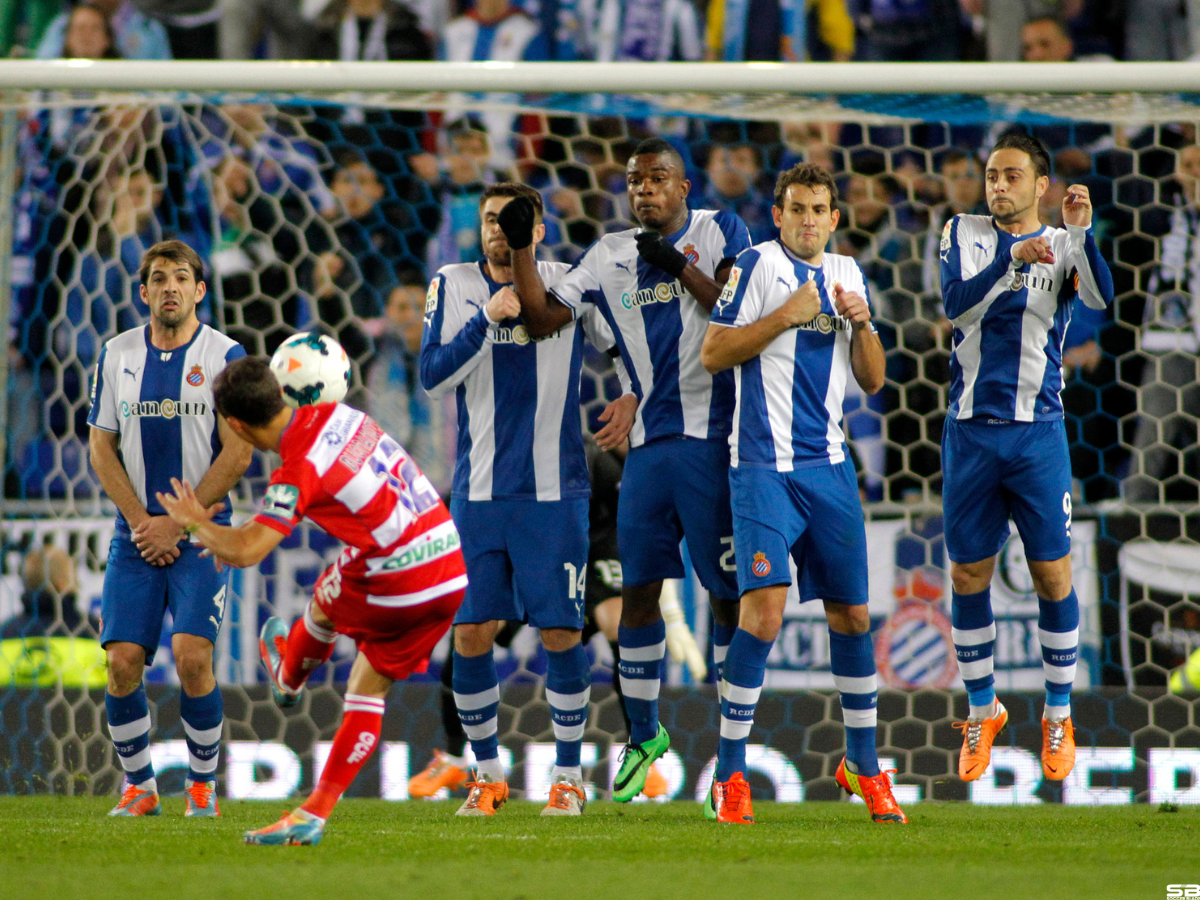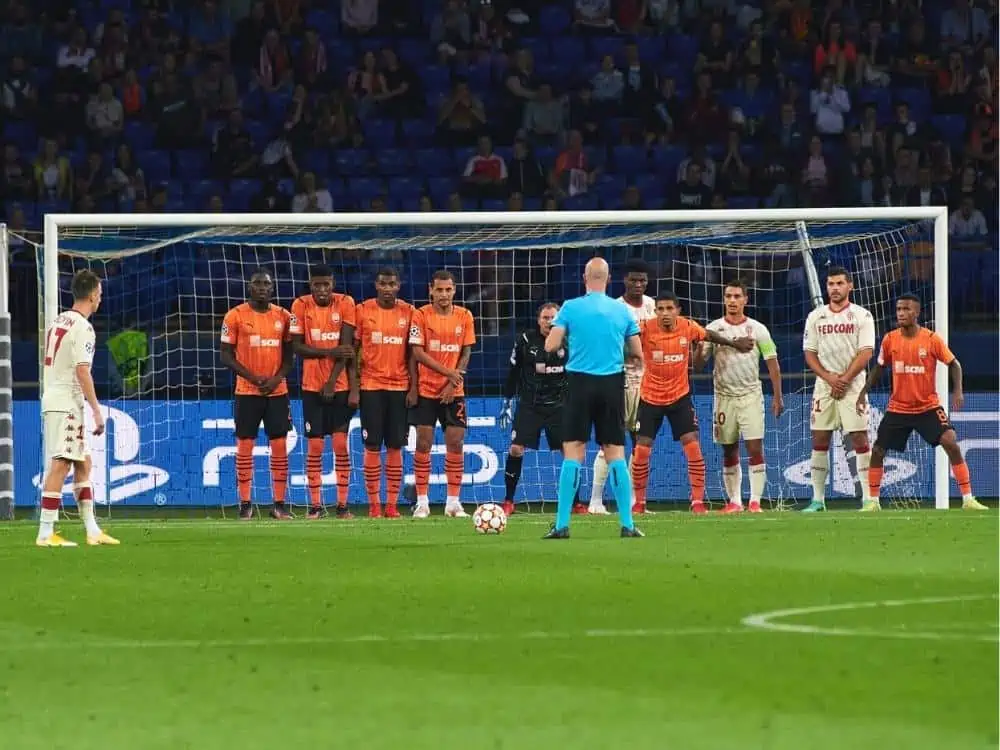Share the post "Curve a Soccer Ball: Bend It Like The Pros – Mastering the Art of the Perfect Swerve"
In soccer, “bending” the ball is a talent valued for its practicality and beauty. David Beckham and Roberto Carlos excelled with this method. How these athletes can make the ball curve through the air and pass a wall of defenders into the net has always impressed me. Once mastered, scientific concepts can increase the precision and efficacy of this specialty stroke of curling a soccer ball.
Technique and ball aerodynamics are needed to curve a soccer ball. From stance and approach to ball contact, every movement affects the ball’s flight path. The ball’s curving trajectory depends on my foot placement and striking technique, which impart the appropriate spin. The Magnus effect, where an object rotates and creates a vortex of air around it, provides a pressure difference on either side of the ball, affecting its flight.
Learning to curve a soccer ball involves practice and a grasp of minor changes in direction. Weather conditions like wind and air density can alter ball movement. By improving my technique and understanding physics, I can hit curving strokes like the pros. Mastering the curve can change a soccer game, whether you’re shooting for the top corner or bending a pass around an opponent.

Fundamentals of Curving a Soccer Ball
Curving a soccer ball effectively involves precise technique combined with an understanding of physics principles such as spin and aerodynamics.
Watch our video on how to curve a soccer ball:
Understanding Ball Spin and Aerodynamics
When I kick a soccer ball with a curve, my goal is to create significant spin. This spin is crucial because it leads to a difference in air pressure on either side of the ball due to the Magnus effect. To visualize the Magnus effect, think of airflow being deflected in the direction of the spin, which reduces pressure on that side of the ball and results in the opposite side pushing the ball towards the low-pressure area. Essentially, if I kick the ball with a clockwise spin, it will curve right; if I kick it counterclockwise, it will curve left.
Here’s how the Magnus effect works in steps:
- Contact: I hit the ball with my foot on the side, not dead center.
- Spin: The ball starts spinning in the direction opposite to where I struck it.
- Airflow Disruption: One side of the ball moves with the air flow, the other moves against it.
- Pressure Differential: Lower pressure forms on the side where the ball’s spin moves with the airflow.
- Curvature: The ball bends towards the lower pressure side, creating the curve I aim for.
The Role of Gravity and Air Resistance
Gravity and air resistance are two forces that constantly act on the ball. While gravity pulls the ball toward the ground, air resistance slows down the ball’s travel, affecting how far and how fast it can curve. When I curve a ball, I need to consider both forces to predict its trajectory accurately. The spin I impart on the ball not only dictates its curving path through the air but also influences how these forces interact with the soccer ball.
- Gravity: It affects the vertical motion, pulling the ball downwards.
- Air Resistance: It primarily affects the horizontal motion, it slows down the ball as it moves forward, which can lessen the curve.
By leveraging the right combination of spin and power behind my kick, I can partially counteract these forces, allowing the ball to travel in a curved path before gravity pulls it down, achieving what’s known as a bending shot.

Techniques for Curving the Ball
To bend a soccer ball like the pros, mastering the technique of applying spin is essential. We’ll explore the inside and outside curve techniques.
Inside Curve Technique
For the inside curve, you position your body to the opposite side of the direction you want the ball to curve. Strike the ball with the inside of your foot:
- Positioning: Stand at a 45-degree angle to your target.
- Approach: As I approach the ball, I take a last step with my non-kicking foot close to the side of the ball.
- Contact: I hit the lower side part of the ball slightly off-center with the inside of my foot.
- Follow-through: My follow-through continues in the direction I want the ball to curve, with my body leaning over the ball to maintain control.
Outside Curve Technique
The outside curve involves striking the ball with the outside part of your foot. This is how I do it:
- Positioning: I position myself slightly facing the target.
- Approach: Taking a diagonal approach, I keep my non-kicking foot a bit behind and to the side of the ball.
- Contact: The ball is hit near the bottom and off-center, with the outside of my foot.
- Follow-through: My kicking leg follows through across my body, pointing towards where I want the ball to go.
Preparation and Practice
Mastering the technique of curving a soccer ball demands consistent preparation and practice. This lays the foundation for the physical and technical aspects required to bend a soccer ball accurately.
Warm-Up Exercises
Before I begin practicing my ball curving technique, I ensure that my body is thoroughly warm to prevent injuries. My warm-up regimen consists of:
- Jogging: I jog slowly around the field for about 5 to 10 minutes.
- Dynamic Stretching: After jogging, I focus on dynamic stretches for my legs, particularly targeting my hamstrings, quadriceps, and calf muscles.
- Ball Touches: I perform light ball touches and dribbles to get a feel for the ball.
Drilling the Basics
Next, I shift my attention to drilling the fundamental techniques required for curving the ball:
Body Position and Approach: I practice approaching the ball from an angle, with my foot planting beside the ball—not too close, but with enough space to swing my kicking foot follow-through.
Contact Technique: I focus on striking the lower right or left side of the ball, depending on the desired direction of the curve, with the inside of my foot. My ankle stays locked to ensure clean, precise contact.
Follow-Through: The follow-through is crucial for generating spin. I practice following through across my body, ensuring that my kicking foot moves in the direction that I want the ball to curve.
Consistent practice of these elements is essential for developing the skill to curve a soccer ball accurately.

Advanced Curving Methods
To elevate your game, let’s explore advanced techniques that professional players use to curve the soccer ball with precision.
Incorporating Body Movement
When I curve a ball, my entire body contributes to the action. For a powerful outside curve, I plant my non-kicking foot close to the ball, angle my body away from the target, and strike the ball’s side with the outside of my foot. As I follow through, I ensure that my kicking leg swings across my body, which adds spin to the ball.
Key Points:
- Planting Foot: Keep it close to the ball.
- Body Angle: Position your body away from the target.
- Strike and Follow Through: Hit the ball’s side and swing the kicking leg across your body.
Mastering the Knuckleball Effect
The knuckleball is an unpredictable and difficult technique to defend against. I hit the ball dead center with as little spin as possible using my knuckles to create a knuckle effect. The key is to hit the ball with a firm and steady approach, making contact with the valve to increase the chances of the knuckleball.
Key Points:
- Contact: Strike the center of the ball with a firm approach.
- Ball Valve: Aim for the valve to help generate the knuckle effect.
- Posture and Technique: Maintain a controlled, balanced stance for accuracy.
Scientific Analysis
In analyzing the science behind curving a soccer ball, I’ll focus on the key aspects of physics and environmental factors that impact the ball’s trajectory.
Physics Behind Ball Curvature
The phenomenon that allows a soccer ball to curve in the air is known as the Magnus effect. When I kick the ball with a spin, the air pressure on one side of the ball drops while increasing on the opposite side, creating a pressure difference. This is due to the ball’s rotation dragging air along its surface, speeding up the airflow on one side and slowing it down on the other. The result is a curving motion away from the higher pressure area.
- Spin Direction: Dictates curve direction
- Spin Speed: More spin equals more curve
Influence of Environmental Conditions
Environmental factors play a significant role in how a soccer ball behaves in the air.
- Altitude: At higher altitudes, where the air is thinner, the ball experiences less air resistance and can curve more.
- High Altitude = Thinner Air = Increased Curve
- Low Altitude = Denser Air = Decreased Curve
- Humidity: Wet conditions can affect the ball’s ability to spin, potentially reducing curvature.
- Dry = Better Spin
- Wet = Possible Spin Reduction
- Wind: Crosswinds can amplify or mitigate the ball’s curvature.
- Tailwind = Increased Speed, Possible Curve Change
- Headwind = Slowed Speed, Increased Curve
Using italic and bold for emphasis, I’ve outlined the core scientific elements that influence a soccer ball’s curved path during a game, underlining how crucial these factors are for players who want to bend it like the pros.

Match-Play Strategies
Mastering the art of curving a soccer ball can give me a significant advantage during match-play, but knowing when and how to incorporate it effectively is crucial.
Choosing the Right Moment to Curve
When I’m on the pitch, recognizing the optimal moment to curve a ball is paramount. I tend to look for scenarios such as free kicks, corners, or open play where defenses are less compact. In these moments, curving the ball can exploit gaps in the defensive setup. For free kicks near the penalty area, I prefer curving the ball around the wall towards the far post, as goalkeepers often have a hard time predicting the flight of the ball. During corners, a well-placed curve can make the ball swing away from the keeper, creating better scoring opportunities for my teammates.
Combining Curves with Other Soccer Skills
Integrating curving techniques with my overall skill set enhances my effectiveness and unpredictability. When taking on defenders, I sometimes use a curve to bend passes around them or to shape shots into the corners of the goal. My decision to curve a pass or a shot is influenced by the position of my teammates and opponents. I continuously assess factors such as:
- Teammate positioning: I look for cues that a teammate is ready for a curved pass that can bypass defenders.
- Opponent’s balance: If an opponent is off-balance, a curved shot can be particularly effective.
- Keeper’s positioning: I exploit the keeper’s position by curving shots away from their reach.
Incorporating the curve technique with other skills, like dribbling and passing, forms a vital part of my match-play strategies, making it harder for opponents to predict my next move.
Training Drills and Equipment
To master the art of curving a soccer ball, incorporating specific training drills and using the right equipment is crucial. It enables me to refine my technique and become more consistent with my shots.
Recommended Soccer Balls for Practice
When selecting soccer balls for practice, I find that the Adidas Performance Starlancer V is a fantastic choice due to its consistent flight and durability. Another ball I often use is the Nike Aerowsculpt, which boasts a textured surface that aids in practicing spins.
| Soccer Ball Model | Why It’s Good for Practice |
|---|---|
| Adidas Performance Starlancer V | Durable; offers consistent flight. |
| Nike Aerowsculpt | Textured surface helps with learning spins. |
- Machine-stitched, standard size soccer ball
- KEEPS ITS SHAPE: Butyl bladder for best air retention
- REQUIRES INFLATION: Ships flat, pump not included
Product: Updated 2024-07-24 | Images: Amazon Product Advertising API | #ad – soccerblade.com is an Amazon Associate
Cones and Targets for Accuracy Training
I set up cones in patterns to practice dribbling and curving the ball around obstacles. For targets, I prefer using portable soccer nets with target sheets that emphasize aiming for the corners. I also use SKLZ Quickster Soccer Trainer for rebound practice to improve my precision and control.
- Cones: Useful for setting up dribbling courses and mimicking defender positions.
- Portable Soccer Nets with Target Sheets: Ideal for shooting practice and accuracy.
- SKLZ Quickster Soccer Trainer: Helps in practicing ball control and precise rebounds.
Common Mistakes and Corrections
In learning to curve a soccer ball effectively, some common pitfalls can hinder your technique. Let’s address how to correct these for a more precise bend.
Adjusting your Approach Angle
One common error I notice is the approach angle. Many players approach the ball directly inline, making it difficult to create the necessary spin for a curve. Correction: I recommend approaching the ball at a 20-30 degree angle. This angle allows for the proper swinging motion of the leg to impart the desired spin on the ball.
Fine-Tuning the Contact Point
Another mistake is striking the ball incorrectly. Players often hit the center rather than the side, missing the optimal contact point for curving. Correction: I encourage players to focus on the lower side of the ball, using the area between the inside of the foot and the instep. A precise impact here imparts spin, which is essential for a successful curve shot.
Famous Curve Shots in Soccer History
In this section, I’ll relive some of the most unforgettable curved shots in soccer that have left an indelible mark in the hearts of fans and the annals of the sport.
Iconic Matches and Moments
Throughout the history of soccer, there have been incredible curved shots that turned the tide in monumental matches.
- Roberto Carlos’s Free Kick in 1997: During the inaugural match of Le Tournoi, against France, Roberto Carlos executed a seemingly physics-defying free-kick from 35 yards out. The ball curved so dramatically that it seemed to be heading wide before swooping into the net.
- David Beckham’s Goal Against Greece, 2001: In a World Cup qualifier, Beckham curved a last-minute free-kick to secure England’s place in the tournament, sparking wild celebrations across the nation.
Share the post "Curve a Soccer Ball: Bend It Like The Pros – Mastering the Art of the Perfect Swerve"
Joel is a seasoned soccer journalist and analyst with many years of experience in the field. Joel specializes in game analysis, player profiles, transfer news, and has a keen eye for the tactical nuances of the game. He played at various levels in the game and coached teams - he is happy to share his insight with you.




